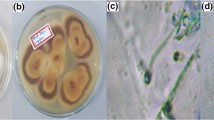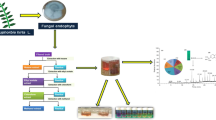Abstract
Fungal isolates (Aspergillus wentii 1, A. wentii 2, Penicillium citrinum, Penicillium granulatum) were selected to study their in vitro antioxidant potential by various assay procedures. Czapek–Dox’s medium was selected for the growth of fungi as it supported the best antioxidant activity based on their EC50 values, P. citrinum was the best followed by P. granulatum, A. wentii 1, and A. wentii 2. The chromatographic analyses showed several compounds possessing antioxidant activity in the fungal extracts. Two such compounds were partially purified from P. citrinum which demonstrated potent antioxidant activity, equally effective or better than some of the standard antioxidants.








Similar content being viewed by others
References
Meghashri, S., Kumar, H. V., & Gopal, S. (2010). Antioxidant properties of a novel flavonoid from leaves of Leucas aspera. Food Chemistry, 122, 105–110.
Singh, R. P., Sharad, S., & Kapur, S. (2004). Free radicals and oxidative stress in neurodegenerative diseases: relevance of dietary antioxidants. Journal Indian Academy Clinical Medicine, 5, 218–225.
Yang, J.-H., Lin, H.-C., & Mau, J.-L. (2002). Antioxidant properties of several commercial mushrooms. Food Chemistry, 77, 229–235.
Devasagayam, T. P. A., & Kamat, J. P. (2002). Biological significance of singlet oxygen. Indian Journal of Experimental Biology, 40, 680–692.
Halliwell, B. (2000). Lipid peroxidation, antioxidants and cardiovascular disease: how should we move forward? Cardiovascular Research, 47, 410–418.
Trouillas, P., Marsa, P., Siri, D., Lazzaron, R., & Duroux, J.-L. (2006). A DFT study of the reactivity of OH groups in quercetin and taxifolin antioxidants: the specificity of the 3-OH site. Food Chemistry, 97, 679–688.
Pereira, J. A., Oliveira, I., Sousa, A., Valentaό, P., Andrade, P. B., Ferreira, I. C. F. R., et al. (2007). Walnut (Juglans regia L.) leaves: phenolic compounds, antibacterial activity and antioxidant potential of different cultivars. Food and Chemical Toxicology, 45, 2287–2295.
Bhattarai, H. D., Paudel, B., Hong, S. G., Lee, H. K., & Yim, J. H. (2008). Thin layer chromatography analysis of antioxidant constituents of lichens from Antarctica. Journal of Natural Medicine, 62, 481–484.
Zhao, R., Xiang, Z. J., Ye, T. X., Yaun, J. Y., & Guo, X. Z. (2006). Antioxidant activities of Salvia miltiorrhiza and Panax notoginseng. Food Chemistry, 99, 767–774.
Chang, L. W., Yen, W. J., Huang, S. C., & Duh, P. D. (2002). Antioxidant activity of sesame coat. Food Chemistry, 78, 347–354.
Othman, A., Ismail, A., Ghani, N. A., & Adenan, I. (2007). Antioxidant capacity and phenolic content of cocoa beans. Food Chemistry, 100, 1523–1530.
Kang, K. S., Yokozawa, T., Kim, H. Y., & Park, J. H. (2006). Study on the nitric oxide scavenging effects of ginseng and its compound. Journal of Agricultural and Food Chemistry, 54, 2558–2562.
Singleton, V. L., Ortofehr, R., & Lamuela-Raventos, R. M. (1999). Analysis of total phenols and other oxidation substrate and antioxidants by means of Folin–Ciocalteau reagent. Methods in Enzymology, 299, 152–178.
Maron, D., & Ames, B. (1983). Revised methods for the Salmonella mutagenicity test. Mutation Research, 113, 173–215.
Ciapetti, G., Cenni, E., Pratelli, L., & Pizzoferrato, A. (1993). In vitro evaluation of cell/biomaterial interaction by MTT assay. Biomaterials, 14, 359–364.
Behera, B. C., Verma, N., Sonone, A., & Makhija, U. (2006). Determination of antioxidative potential of lichen Usnea ghattensis in vitro. LWT Food Science and Technology, 39, 80–85.
Chandra, P., & Arora, D. S. (2009). Antioxidant activity of fungi isolated from soil of different areas of Punjab, India. Journal of Applied and Natural Science, 1, 123–128.
Huang, W. Y., Cai, Y. Z., Hyde, K. D., Corke, H., & Sun, M. (2007). Endophytic fungi from Nerium oleander L (Apocynaceae): main constituents and antioxidant activity. World Journal of Microbiology & Biotechnology, 23, 1253–1263.
Song, T. Y., & Yen, G. C. (2002). Antioxidant properties of Antrodia camphorata in submerged culture. Journal of Agricultural and Food Chemistry, 50, 3322–3327.
Gebhardt, P., Dornberger, K., Gollmick, F. A., Grafe, N., Hartl, A., Gorls, H., et al. (2007). Quercinol, an anti-inflammatory chromene from the wood-rotting fungus Daedalea quercina (Oak Mazegill). Bioorganic & Medicinal Chemistry Letters, 17, 2558–2560.
Bounatirou, S., Smiti, S., Miguel, M. G., Falerio, L., Rejeb, M. N., Neffati, M., et al. (2007). Chemical composition, antioxidant and antibacterial activities of the essential oils isolated from Tunisian Thymus capitatus Hoff. et Link. Food Chemistry, 105, 146–155.
Liua, X., Zhaoa, M., Wanga, J., Yangb, B., & Jiang, Y. (2008). Antioxidant activity of methanolic extract of emblica fruit (Phyllanthus emblica L.) from six regions in China. Journal of Food Composition and Analysis, 21, 219–228.
Lo, K. M., & Cheung, P. C. K. (2005). Antioxidant activity of extracts from the fruiting bodies of Agrocybe aegerita var. alba. Food Chemistry, 89, 533–539.
Lee, I.-H., Hung, Y.-H., & Chou, C.-C. (2007). Total phenolic and anthocyanin contents, as well as antioxidant activity, of black bean koji fermented by Aspergillus awamori under different culture conditions. Food Chemistry, 104, 936–942.
Gursoy, N., Sarikurkcu, C., Cengiz, M., & Solak, M. H. (2009). Antioxidant activities, metal contents, total phenolics and flavonoids of seven Morchella species. Food and Chemical Toxicology, 47, 2381–2388.
Elzaawely, A. A., Xuan, T. D., Koyama, H., & Tawata, S. (2007). Antioxidant activity and contents of essential oil and phenolic compounds in flowers and seeds of Alpinia zerumbet (Pers.) B.L. Burtt. & R.M. Sm. Food Chemistry, 104, 1648–1653.
Thitilertdecha, N., Teerawutgulrag, A., & Rakariyatham, N. (2008). Antioxidant and antibacterial activities of Nephelium lappaceum L. extracts. LWT Food Science and Technology, 41, 2029–2035.
Arora, D. S., & Chandra, P. (2010). Assay of antioxidant potential of two Aspergillus isolates by different methods under various physio-chemical conditions. Brazilian Journal of Microbiology, 41, 465–477.
Arora, D. S., & Chandra, P. (2010). Optimization of antioxidant potential Aspergillus terreus through different statistical approaches. Biotechnology and Applied Biochemistry, 57, 77–86.
Sharma, R. K., Chandra, P., & Arora, D. S. (2010). Antioxidant properties and nutritional value of wheat straw bioproccessed Phanerocheate chrysosporium and Daedalea flavida. The Journal of General and Applied Microbiology, 56, 519–523.
Moon, B. S., Ryoo, I. J., Yun, B. S., Bae, K. S., Lee, K. D., Yoo, I. D., et al. (2006). Glyscavins A, B and C, new phenolic glycoside antioxidants produced by a fungus Mycelia sterilia F020054. The Journal of Antibiotics, 59, 735–739.
Rios, M. F., Pajan, C. M. G., Galan, R. H., Sanchez, A. J. M., & Callado, I. G. (2006). Synthesis and free radical scavenging activity of a novel metabolite from the fungus Colletotrichum gloeosporioides. Bioorganic & Medicinal Chemistry Letters, 16, 5836–5839.
Harper, K., Arif, A., Ford, E. J., Strobel, G. A., Porco, J. A., Jr., Tomar, D. P., et al. (2003). Pestacin: a 1,3-dihydro isobenzofuran from Pestalotiopsis micropora possessing antioxidant and antimycotic activities. Tetrahedron, 59, 2471–2476.
Yen, G. C., & Chang, Y. C. (1999). Medium optimization for the production of antioxidants from Aspergillus candidus. Journal of Food Protection, 62, 657–661.
Yen, G. C., & Lee, C. A. (1996). Antioxidant activity of extracts from molds. Journal of Food Protection, 59, 1327–1330.
Acknowledgment
Priyanka Chandra is thankful to UGC for the Rajiv Gandhi National Fellowship vide no. F.42 (SC)/2008 (SA-III).
Author information
Authors and Affiliations
Corresponding author
Rights and permissions
About this article
Cite this article
Arora, D.S., Chandra, P. In Vitro Antioxidant Potential of Some Soil Fungi: Screening of Functional Compounds and their Purification from Penicillium citrinum . Appl Biochem Biotechnol 165, 639–651 (2011). https://doi.org/10.1007/s12010-011-9282-3
Received:
Accepted:
Published:
Issue Date:
DOI: https://doi.org/10.1007/s12010-011-9282-3




